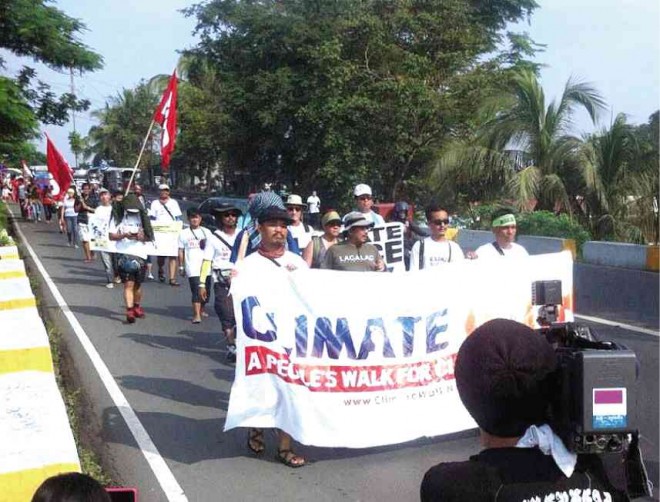
CLIMATE advocates embark on a 1,000-kilometer walk to raise public awareness on the effects of climate change and global warming. The group hopes to arrive in Tacloban City, Leyte province, the Ground Zero of Supertyphoon “Yolanda,” on Nov. 8. CONTRIBUTED PHOTO
LOS BAÑOS, Laguna—They may just be a small group of able bodies but theirs is a message ambitious and urgent: “Climate change does exist.”
With streamers demanding “climate justice” and some of them with solar-panel suitcases in tow, volunteers from environmental and civil society groups are braving erratic weather, road traffic and air pollution in a 1,000-kilometer “climate walk” from Rizal Park in Manila, considered the Philippines’ Kilometer Zero, to Tacloban City, Leyte province.
“It’s a people’s walk from Km 0 to Ground 0,” Nityalila Saulo, the group’s overall command, said in a phone interview on Monday.
With 11 “core walkers,” the group left Rizal Park on Oct. 2 and expects to reach Tacloban on Nov. 8, in time for the first anniversary of Supertyphoon “Yolanda” (international name: Haiyan). It hopes to pay tribute to the over 6,000 people killed when Yolanda, one of the strongest-ever typhoons recorded in recent history, made landfall in Tacloban.
“Some (volunteers) would join in some parts of the walk. Right now, there are 16 of us,” said Saulo, a member of the advocacy group Dakila. The youngest, 15-year-old Bam Azores from Manila, walks on crutches due to a leg injury.
Also supporting the climate walk are members of Greenpeace, Aksyon Klima Pilipinas, Fast for the Climate and Climate Reality Project.
As of Monday, the group was in San Pablo City, Laguna province, and was off to neighboring Quezon province. They plan to visit evacuation sites in Albay province, which is currently teeming with thousands who were displaced by the impending eruption of Mayon Volcano.
From Matnog town, Sorsogon province, they would take a barge to Allen town, Northern Samar province, and continue their walk. “So far, [a health concern is] the blisters on our feet,” Saulo said.
The group has been spending nights in municipal gymnasiums and churches, and charges cell phone batteries and GPS trackers with their solar panels, “to show people how renewable energy works,” Saulo said.
They also hold short programs and talks in communities along the way to raise awareness on the effects of climate change.
“Awareness in the Philippines is still far low,” Saulo said. “When people see us walk with all our streamers, they begin to ask why. And that sparks their interest,” she said.
The climate walk is the first significant long march of climate advocates in the Philippines, considered a country vulnerable to the effects of climate change.
“An important reflection [since Yolanda] is that one country cannot [confront the climate crisis] alone. It is for our world leaders to take serious, ambitious, urgent and concrete actions,” Philippine Climate Change Commissioner Naderev “Yeb” Saño said in a phone interview.
A walker himself, Saño, who is from Tacloban City, delivered an emotional speech and embarked on a seven-day fast at the United Nations (UN) climate talks last year to push for commitments from the more-developed countries.
The climate walk, he said, was also meant to stir local public opinion in preparation for the UN Climate Convention to be held in 2015 in Paris.
Talks to address climate change began in 2007, drawing up a binding agreement among countries to reduce greenhouse gas emission, fund renewable energy, construct mass transport systems and limit global temperature to
2 degrees Celsius, he said.
“It’s just that our fear is that nothing (no concrete commitment) would again be finalized in the 2015 Paris Convention,” Saño said.